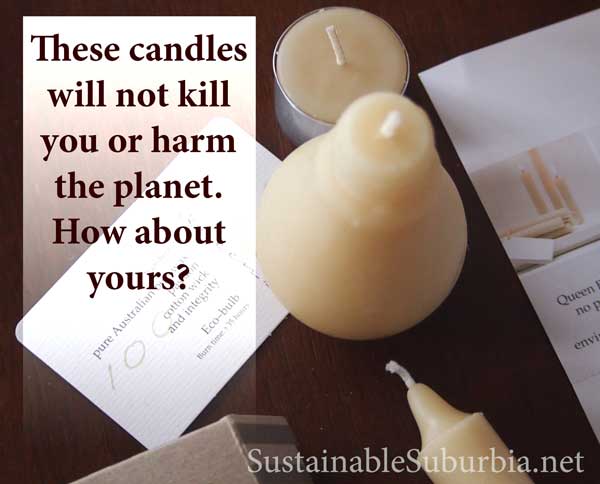
Did you know that paraffin candles are made from a petroleum waste product? That they start as a greyish-black sludge which is bleached with 100% pure bleach (whereas the bleach we consider nasty in the laundry is only 10%), creating billions of tonnes of dioxin, and doing who knows what to the candle you then burn inside your home?
(NB Scroll to the bottom if you just care about the free gift offer!)
And according to the article by Cate Burton, from Queen B Candles, in my forthcoming book, Living Less Toxic: How to Reduce Your Exposure to Toxic Chemicals – an Introduction for Families, even candles sold as ‘beeswax’ can sometimes contain up to 90% paraffin!
If the fact that your everyday candles are bleached petroleum wasn’t enough to worry you, studies have found that burning them releases benzene, toluene and ketones into the air, and also that candles with lead or zinc core wicks emit potentially dangerous levels of lead (which then collects in your house dust) and other chemicals including mercury! Lead wicks have been banned in Australia, but it is not unusual for zinc wicks to be contaminated with lead, and lead wicks have also been found in cheap imports, even since the ban.
So what should you do?
Should you switch to soy or palm? Cate Burton says no. Admittedly Cate makes and sells beeswax candles, but there’s a reason she chooses pure beeswax. There are potential toxicity issues with both of soy and palm candles, particularly once they are coloured and scented, and there are also serious environmental impacts. Aside from the fact that they are also bleached (again creating tonnes of dioxins), these crops are also responsible for massive deforestation.
Many readers will be familiar with the issue of disappearing habitat for the endangered orang-utans due to palm oil production. But did you know that soy has similar issues? According to a World Wildlife Fund study, soy is the most important driver of deforestation.
So what about Beeswax?
Okay, here’s the bad news, straight up: Australian beeswax costs up to 50 times as much as paraffin.
The good news for the consumer is that beeswax candle manufacturers absorb some of that increased cost (they have to, or they wouldn’t have a market, I guess). There are also cheaper beeswax options available, though the main reason Australian beeswax is the most expensive is that it is free from the chemical residues found in other beeswax, because our hives don’t have to be treated for varroa mite.
Now, I should tell you that when I asked Cate to submit an article for Less Toxic Living, she not only agreed, but she offered to send me some of her candles to try myself. Of course I said yes! When I unpacked them from the box all my children ooed and ahhed and kept coming back to smell them. I have to admit, to me they didn’t smell like anything in particular (they are not scented at all of course), but the kids thought they smelled like honey. We already had a number of beeswax candles in the house (I do like candles!), but these were quite different, being solid wax rather than rolled sheets of beeswax (though they have them too).
They were also just gorgeous candles and beautifully packaged. I love using an oil burner so I have actually told my kids the 5 hour tealight candles would make a great birthday present for me (my birthday is just a couple of weeks before Christmas). I’ve already used most of the ones Cate sent!
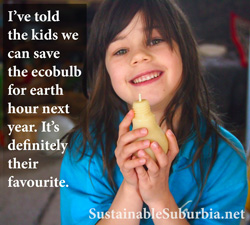 When I told Cate I loved them so much I wanted to write a blog post about beeswax, she offered to do a little something extra for readers who want to buy some candles for my birthday, for themselves, or perhaps for Christmas pressies.
When I told Cate I loved them so much I wanted to write a blog post about beeswax, she offered to do a little something extra for readers who want to buy some candles for my birthday, for themselves, or perhaps for Christmas pressies.
Anyone who mentions “Sustainable Suburbia” in the comments field when they checkout will receive a free gift of a round votive candle in glass – RRP $9.95 – on any order over $100, or a free Ecobulb candle (pictured) for orders over $200. Orders over $100 also receive free shipping within Australia. Offer valid until 16 December 2013 (which is also the last day you can safely order for Christmas in some parts of the country). Naturally, this offer is not to be used in conjunction with another offer. (I know, that’s common sense, but I thought I should mention it.)
 This is going to start to sound like an ad for a second, but honestly, when I found the Queen B website, I was overwhelmed with how beautiful some of their fancier, hand painted, candles are.
This is going to start to sound like an ad for a second, but honestly, when I found the Queen B website, I was overwhelmed with how beautiful some of their fancier, hand painted, candles are.
But funnily the ones I most want for myself are the ‘make your own’ tea light candle kits. I love that they have all the supplies on there to make your own, from tea lights to tapers.
So now, over to you: do you use candles much? Have I just put you off using up your supply of paraffin candles? Personally, I’m not throwing mine away – the environmental damage has already been done, and I have a waste not want, not habit – but I’m going to be keeping them for emergencies and for burning outside. And not buying any more!
_____________
Linking up with Jess for IBOT (I Blog On Tuesday).

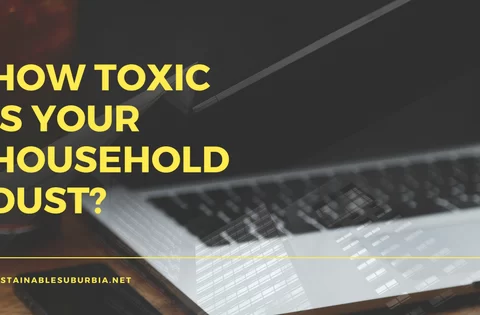
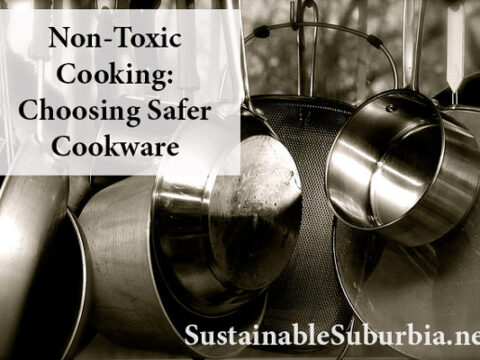
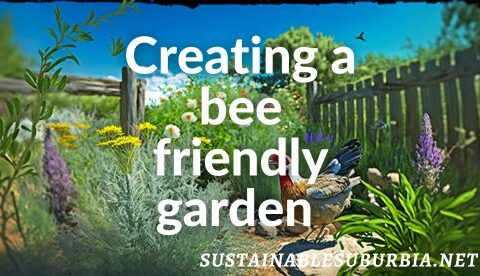

I’ve always been aware that some candles are not good for you and so I’m very careful what I buy. In fact I usually just use aromatherapy oils and wooden sticks instead (mainly as I am so forgetful I worry I might not blow them out before I leave the house). This was so interesting though. Thanks for sharing xx
I love that system with oils and sticks Robyn. And yeah, I do get the worrying about forgetting thing!
Thanks for you comment.
Wow – I certainly didn’t know this and love burning candles most days. I am going to have to look into changing the candles that I use.
Thank you so much for sharing this information for those of us not in the know !
Have the best day !
Me
You’re welcome. It’s something I’ve been sort of vaguely aware of, but didn’t know the details. Once you do, it’s a bit shocking isn’t it?
It never occurred to me that candles could be bad for you! I’ve been burning scented candles for years! Scary stuff. Thanks for the info.
You’re welcome Née Say. I’m in the same boat! Well, not scented mostly (they give me a headache), but coloured and paraffin.
Another thing I didn’t know. I’m like you, I wouldn’t waste what I already have, but it will make me more aware of what I buy in the future.
Yep, mostly I figure, use up what you’ve already bought (and has therefore already done the largest part of it’s polluting), but make changes from now on. In most cases anyway.
I love my candles and I have heard mixed reports about the chemicals. It seems there are chemicals in everything these days. Thanks for the info.
Yeah, that is true enough Bec!
Oh man I never put much thought into it to be honest! So much to consider. I used to buy sheets of beeswax and make my own candles when I was a teenager. Pretty fun! #teamIBOT
Yeah, my daughter’s been given some sheets to make her own. Always a nice activity I think
When I first started learning to make candles is when I learned about paraffin and also the toxins in some of the wicks. So now I make soy candles with bare wicks. I enjoy the making process and knowing that I’m bringing less toxins in my home.
What an informative website you have here. So happy to have stumbled upon it via Little Eco Footprints.
Cheers!